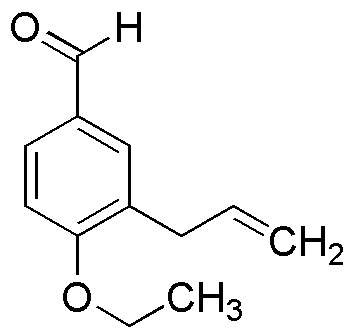3-Allyl-4-ethoxybenzaldehyde is widely utilized in research focused on:
- Flavor and Fragrance Industry: This compound is used as a flavoring agent and fragrance component, providing a unique aroma that enhances food products and perfumes.
- Pharmaceutical Development: It serves as an intermediate in the synthesis of various pharmaceuticals, contributing to the development of new medications with improved efficacy.
- Organic Synthesis: Researchers employ this compound in organic synthesis reactions, particularly in the creation of complex organic molecules, due to its reactive allyl group.
- Material Science: It is explored in the formulation of specialty polymers and resins, offering enhanced properties such as flexibility and durability for various applications.
- Biological Research: The compound is studied for its potential biological activities, including anti-inflammatory and antioxidant properties, paving the way for new therapeutic agents.
Informations générales
Propriétés
Sécurité et réglementation
Applications
3-Allyl-4-ethoxybenzaldehyde is widely utilized in research focused on:
- Flavor and Fragrance Industry: This compound is used as a flavoring agent and fragrance component, providing a unique aroma that enhances food products and perfumes.
- Pharmaceutical Development: It serves as an intermediate in the synthesis of various pharmaceuticals, contributing to the development of new medications with improved efficacy.
- Organic Synthesis: Researchers employ this compound in organic synthesis reactions, particularly in the creation of complex organic molecules, due to its reactive allyl group.
- Material Science: It is explored in the formulation of specialty polymers and resins, offering enhanced properties such as flexibility and durability for various applications.
- Biological Research: The compound is studied for its potential biological activities, including anti-inflammatory and antioxidant properties, paving the way for new therapeutic agents.
Documents
Fiches de données de sécurité (FDS)
La FDS fournit des informations de sécurité complètes sur la manipulation, le stockage et l’élimination du produit.
Spécifications du produit (PS)
Le PS fournit une description complète des propriétés du produit, notamment sa composition chimique, son état physique, sa pureté et les exigences de stockage. Il détaille également les plages de qualité acceptables et les applications prévues du produit.
Certificats d'analyse (COA)
Recherchez des certificats d'analyse (COA) en saisissant le numéro de lot du produit. Les numéros de lot et de lot se trouvent sur l'étiquette d'un produit, après les mots « Lot » ou « Lot de fabrication ».
Numéro de catalogue
Numéro de lot/série
Certificats d'origine (COO)
Ce certificat d'exploitation confirme le pays dans lequel le produit a été fabriqué, et détaille également les matériaux et composants utilisés et s'il est issu de sources naturelles, synthétiques ou autres sources spécifiques. Ce certificat peut être requis pour les douanes, le commerce et la conformité réglementaire.
Numéro de catalogue
Numéro de lot/série
Fiches de données de sécurité (FDS)
La FDS fournit des informations de sécurité complètes sur la manipulation, le stockage et l’élimination du produit.
DownloadSpécifications du produit (PS)
Le PS fournit une description complète des propriétés du produit, notamment sa composition chimique, son état physique, sa pureté et les exigences de stockage. Il détaille également les plages de qualité acceptables et les applications prévues du produit.
DownloadCertificats d'analyse (COA)
Recherchez des certificats d'analyse (COA) en saisissant le numéro de lot du produit. Les numéros de lot et de lot se trouvent sur l'étiquette d'un produit, après les mots « Lot » ou « Lot de fabrication ».
Numéro de catalogue
Numéro de lot/série
Certificats d'origine (COO)
Ce certificat d'exploitation confirme le pays dans lequel le produit a été fabriqué, et détaille également les matériaux et composants utilisés et s'il est issu de sources naturelles, synthétiques ou autres sources spécifiques. Ce certificat peut être requis pour les douanes, le commerce et la conformité réglementaire.


